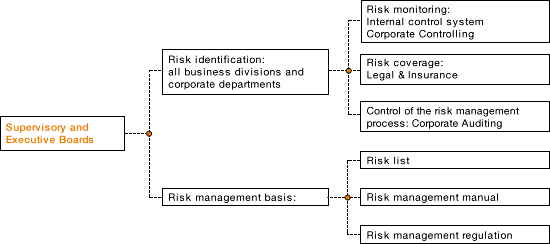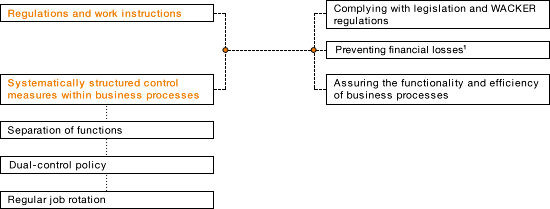WACKER’s risk management system spans a variety of aspects. This groupwide system draws on existing organizational and reporting structures, supplemented by additional elements:
- The risk management handbook: The handbook contains the risk management system’s principles and processes. It explains reportable levels of risks and how risks are to be covered and mapped.
- The risk management regulation: It stipulates groupwide reporting requirements, including when a specific committee must be informed.
- The risk management coordinator: This coordinator is responsible for the risk management system and is supported by local risk coordinators.
- The risk list: In this list, we record each specific risk facing our divisions and other corporate sectors. Reporting is mandatory for individual risks where the effect on earnings would exceed €5 million.

We analyze and assess each identified risk’s probability of occurrence and potential effects on earnings. Corporate Controlling compiles a monthly report to inform the Executive Board of current and future business developments. We evaluate and balance risks and opportunities at regular meetings with our divisions.
Corporate Controlling ensures that our risk management standards are implemented and that our risk management process is refined. It not only records every substantial risk groupwide, but also evaluates them systematically according to uniform criteria. Major risks and those endangering the continued existence of the company are immediately communicated via ad-hoc reporting. As the divisions are responsible for their own results, this process is closely interwoven with operational controlling. Individual divisional risks are identified and evaluated on a monthly basis. Operational risk management is thus firmly rooted in the divisions. At the same time, Corporate Finance, Corporate Accounting, Raw Materials Procurement, Technical Procurement & Logistics and Legal & Insurance are integrated into risk controlling at the Group level.
Financial risks are managed at Corporate Finance, which is responsible for all measures relating to exchange-rate and interest-hedging transactions, and for all measures needed to ensure adequate Group liquidity. WACKER’s scope of action is set out in detailed specifications and regulations covering, for example, separation of trading and settlement functions. Corporate Accounting monitors receivables management vis-à-vis customers and suppliers.
Internal Control System (ICS) and Internal Control System for Accounting
Our internal control system (ICS) is an integral component of our risk management system.

1 Possible financial losses due to the intentional or inadvertent misconduct of our
employees or third parties
We use our “internal control system for accounting practices” to implement and comply with legal stipulations and the principles of proper accounting, as well as the rules of the International Financial Reporting Standards (IFRS) and of the internal control system itself. This compliance is essential for providing our stakeholders (such as investors, banks and analysts) with proper and reliable information.
In addition to the ICS principles already mentioned, we perform assessments and analyses to help identify and minimize any risks with a direct influence on financial reporting. We continually monitor changes in accounting standards and extensively and regularly train our employees accordingly. We enlist external experts to reduce the risk of accounting misstatements in complex and challenging issues, such as pensions.
Our internal accounting control system is designed to ensure that our accountants process every business transaction promptly, uniformly and correctly and that reliable data on the Group’s profitability, assets and financial performance are constantly available. The aim is to ensure that we comply with legal stipulations, accounting standards and internal accounting rules. These are binding for all Group companies included in our consolidated financial statements. A key accounting regulation takes the form of an accounting manual, which is valid groupwide. It is available in the WACKER intranet. Additionally, organizational workflows are defined in accounting and organizational regulations, and in book-entry instructions. A groupwide calendar of deadlines guarantees the complete and timely processing of financial statements. By separating financial functions between accounting, statement analysis and strategy, we ensure that potential errors are identified prior to finalization of the statements and that accounting standards are complied with. To safeguard the completeness and accuracy of processes, we have implemented access rules for IT systems and dual-control policies for accounting at individual entities and for Group consolidation reports within WACKER.
Our subsidiaries ensure that existing stipulations are implemented decentrally in their regions. In doing so, they are supported and monitored by Corporate Accounting. Additionally, country-specific accounting standards exist that must be complied with.
We guarantee the effectiveness of controls not only through feedback talks with the employees responsible, but also by continually monitoring key financial indicators in our monthly management reports and in system-supported test runs. Moreover, regular external audits and reviews are carried out at year-end and for each quarter.
Internal Controls
Corporate Auditing rounds out our risk management system. Supported by the auditing manual, this department – on behalf of the Executive Board in consultation with the Audit Committee – checks all corporate entities. The Executive Board adopts a risk-driven approach when choosing audit topics, which, if necessary, are flexibly adjusted during the year to take account of changes in underlying conditions. In 2011, WACKER focused on the following topics:
- Investment projects and technical maintenance
- Auditing of cross-functional business processes at twelve subsidiaries
- Plant safety
- Accounting processes.
In total, Corporate Auditing conducted 37 audits in 2011 (2010: 37 audits). The proposed audit plan was largely implemented, with two topics or items for review to be completed in the course of 2012. No major complaints came to light. Audit recommendations to optimize processes are being implemented.
External Controls
An external auditor examines our early-warning, risk-detection system when auditing our annual financial statements. The auditor then reports to the Executive and Supervisory Boards.




